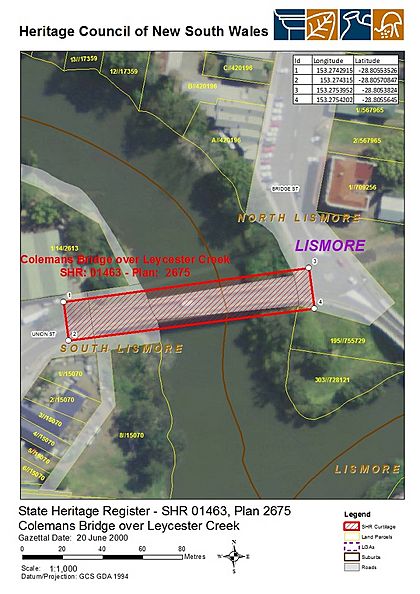Colemans Bridge facts for kids
Quick facts for kids Colemans Bridge |
|
|---|---|

Colemans Bridge over Leycester Creek, heritage boundaries
|
|
| Followed by | Ballina Street bridge (Bruxner Highway), Wilsons River |
| Characteristics | |
| Design | Dare truss |
| History | |
| Architect | Harvey Dare |
| Constructed by | W. F. Oakes |
| Official name: Colemans Bridge over Leycester Creek | |
| Type: | state heritage (built) |
| Designated: | 20 June 2000 |
| Reference #: | 1463 |
| Type: | Road Bridge |
| Category: | Transport - Land |
| Builders: | W. F. Oakes |
The Colemans Bridge is a special road bridge in Lismore, Australia. It carries Union Street across Leycester Creek. This bridge is very old and important, so it's listed on the New South Wales State Heritage Register.
It was designed by Harvey Dare and built in 1907 by W. F. Oakes. The bridge is owned by Roads and Maritime Services, a government agency in New South Wales. It was added to the heritage list on 20 June 2000.
Contents
A Look Back in Time
Why Timber Bridges?
Long ago, before bridges like Colemans Bridge were common, crossing rivers in New South Wales could be tricky. When it rained, rivers would flood. This made it hard and expensive to move goods like farm produce. Only valuable items like wool could be moved easily.
The Public Works Department often chose timber bridges. They were cheap to build. Also, they used materials found nearby. Governments at the time didn't have much money. They wanted lots of roads and bridges built for low cost. This meant they couldn't use imported iron or steel.
Harvey Dare was a top engineer. He worked for the Public Works Department. He designed the "Dare truss" and other bridges. He was a key person in New South Wales in the early 1900s.
Timber bridges were so common in New South Wales. Travellers even called it the "timber bridge state."
Building Colemans Bridge
The Colemans Bridge was built in 1907. A company from Sydney called W. F. Oakes constructed it. It opened in November of that year. It replaced an older bridge that was taken down. A temporary bridge was used during construction.
The bridge was first called the Leycester Creek Bridge. But in December 1907, it got a new name. It was renamed after John Coleman. He was a local politician who had recently passed away. The local council asked for the name change.
Unlike another nearby bridge, this one had a footpath. This was a popular feature for people walking.
What the Bridge Looks Like
Colemans Bridge is a "Dare-type" timber truss road bridge. It has two main timber sections, called trusses. Each truss is about 32 meters (105 feet) long.
There are also smaller timber sections, called approach spans. Two are at one end and one at the other. This makes the bridge about 90.7 meters (297 feet) long in total. The middle of the bridge has two round cast iron supports. Other timber supports hold up the rest of the bridge.
The bridge deck has two lanes for cars. It also has a footpath on both sides for people. The road is at least 6.1 meters (20 feet) wide.
A metal guard rail protects cars. A timber fence forms the handrail for walkers. Curved steel braces help make the outer timber barriers stronger. In 2005, the bridge was reported to be in good shape.
Why Colemans Bridge is Special
What is Heritage Listing?
Colemans Bridge is "heritage-listed." This means it's an important historical site. It's protected so future generations can see it. It shows how bridges were built long ago.
Important Features of the Bridge
Colemans Bridge is an early example of a Dare timber truss bridge. In 1998, it was in good condition. It connects to many important historical events. These include the growth of roads in New South Wales. It also links to Harvey Dare, who designed this type of bridge.
Dare trusses were an improved design. They were similar to older "Allan trusses." But Dare trusses were stronger and easier to keep in good shape. This was a big step forward in bridge design.
Colemans Bridge is special for a few reasons:
- It has iron supports.
- It's the only Dare truss bridge with two lanes.
- It has footpaths for people.
- It has long main sections.
In 1998, 27 Dare trusses were still standing. About 40 were built in total. Out of over 400 timber truss road bridges built, 82 still exist. Colemans Bridge is a great example of a Dare timber truss bridge. It is important for its history and engineering.
Historical Significance
The bridge shows how the road network grew in New South Wales. It also shows how people in NSW started to use American design ideas. Its connection to Harvey Dare also makes it historically important.
Design and Beauty
The bridge shows off its clever design. You can clearly see how it's built. It also looks nice in its surroundings. This gives the bridge good aesthetic value.
Community Value
Timber truss bridges are easy to spot when you travel. New South Wales was once known as the "timber truss bridge state." Many travellers in NSW value these bridges. The people of Lismore also value Colemans Bridge.
Rarity and Uniqueness
Colemans Bridge is quite rare. It has many important technical and beautiful features.
A Great Example
This bridge is a strong example of Dare timber truss bridges. It also shows the bridge technology used in the late 1800s.

